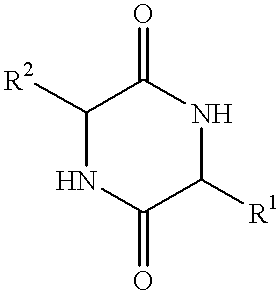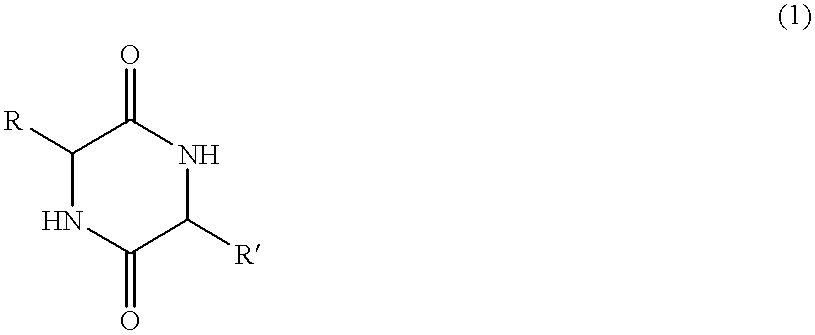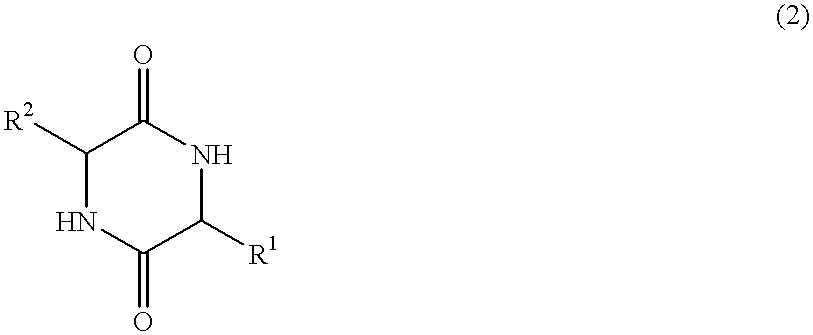Method of synthesizing diketopiperazines
a technology of piperazine and diketopiperazine, which is applied in the direction of immunoglobulins, peptides/protein ingredients, peptides, etc., can solve the problems of similar difficulties, and many workers have encountered difficulties in employing thermal cyclization methods, so as to prevent unwanted side reactions
- Summary
- Abstract
- Description
- Claims
- Application Information
AI Technical Summary
Benefits of technology
Problems solved by technology
Method used
Image
Examples
example 1
Synthesis of Asp-Ala Diketopiperazine (5)
[0039]Wang resin having 9-fluorenylmethyloxycarbonyl-protected alanine (Ala-Fmoc) attached thereto (3 grams (g), 2.52 mmol, 1 equivalent, NovaBiochem™, La Jolla, Calif.) was transferred to a clean round-bottom, 100 mL flask, and a solution of piperidine (12 mL) in dimethylformamide (DMF; 18 mL) was added to the resin in the flask. The solution was swirled for 1 hour, and the resin was isolated in a sintered glass funnel. The resin was washed with DMF (3×30 mL) followed by dichloromethane (DCM; 3×30 mL) and allowed to dry under vacuum for 5 minutes. Preferred protecting groups are 9-fluorenylmethyloxycarbonyl (Fmoc) and t-butoxycarbonyl (Boc).
[0040]The partially-dried resin was transferred into a clean round-bottom, 100 mL flask, and DMF (10 mL) was added. Then, Boc-Asp(OBz)OH (3.25 g,10.07 mmol, 4 equivalents; Aldrich™) was added, followed by diisopropylamine (2.83 mL, 2.04 g, 20.19 mmol, 8 equivalents) and 2-(1H-benzotriazole-1-yl)-1,2,3,3-t...
example 2
Preparation Of Asp-Ala Diketopiperazine Amide (6)
[0044]
[0045]To a solution of 3-methyl-2,5-diketopiperazine-6-acetic acid (0.151 g, 0.81 mmol, 1 equivalent, preparation described in Example 1, 5) in DMF (2.5 mL) was added carbonyl diimidazole (0.26 g, 1.60 mmol, 2 equivalents, Aldrich™ Chemical Co., Milwaukee, Wis.). After stirring at room temperature for 1 hour, solid ammonium acetate (0.63 g, 8.17 mmol, 10 equivalents, Aldrich™) was added. Stirring at room temperature was continued overnight, at which time the reaction was partitioned between water (20 mL) and ethyl acetate (10 mL). The aqueous layer was washed with a second aliquot of ethyl acetate (10 mL), and it was then evaporated to dryness under reduced pressure (61° C.). Traces of DMF were removed by further co-evaporations with water and then toluene to give a white solid (362 mg). This was taken up into a minimum volume of methanol in DCM (20:80 v / v) and flushed through a silica plug (10 g, chromatography grade silica; Al...
example 3
Alternate Syntheses of Asp-Ala Diketopiperazine
[0046]Essentially there are two ways that Asp-Ala diketopiperazine could be prepared, and the two processes are shown schematically below.
In this diagram, R′, R″, and X are protecting groups.
[0047]In Route A, the free α-carboxyl of the alanine is capable of undergoing an intramolecular cyclization with the free amino functional group of the protected aspartic acid. Route B describes the other alternative, whereby the free amino moiety of alanine cyclizes with the free carboxyl of the C-protected aspartic acid.
[0048]Solid phase synthesis (resin), as well as solution phase peptide chemistry, will give the dipeptide isomers, and both of these will yield the Asp-Ala diketopiperazine (5) upon cyclization. The method described in Example 1 is a Route A synthesis. Asp-Ala diketopiperazine has also been synthesized by Route B, and the spectrometric and chromatographic behaviors of the Asp-Ala diketopiperazine synthesized by the two Routes are ...
PUM
| Property | Measurement | Unit |
|---|---|---|
| Temperature | aaaaa | aaaaa |
| Temperature | aaaaa | aaaaa |
| Acidity | aaaaa | aaaaa |
Abstract
Description
Claims
Application Information
 Login to View More
Login to View More - R&D
- Intellectual Property
- Life Sciences
- Materials
- Tech Scout
- Unparalleled Data Quality
- Higher Quality Content
- 60% Fewer Hallucinations
Browse by: Latest US Patents, China's latest patents, Technical Efficacy Thesaurus, Application Domain, Technology Topic, Popular Technical Reports.
© 2025 PatSnap. All rights reserved.Legal|Privacy policy|Modern Slavery Act Transparency Statement|Sitemap|About US| Contact US: help@patsnap.com



